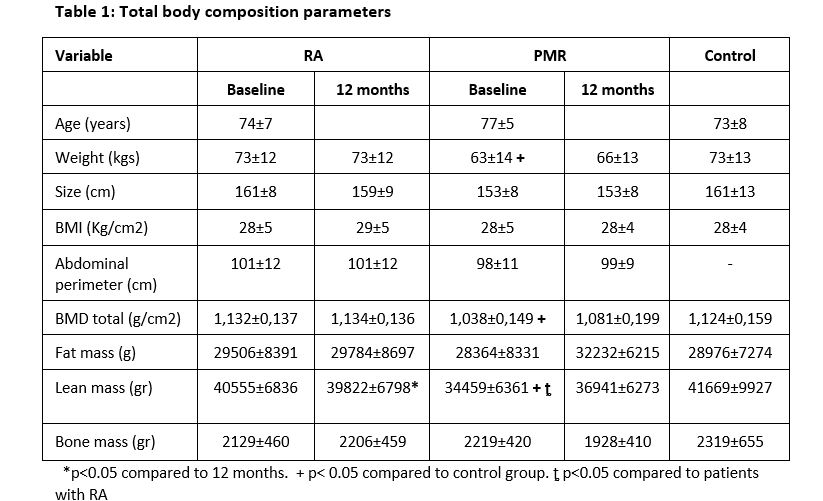Session Information
Session Type: Poster Session A
Session Time: 9:00AM-11:00AM
Background/Purpose: Inflammatory arthritis in the elderly leads to greater comorbidity than that of the young patients, however, there are few data on body composition in this population.
Methods: Objective:
To analyze the total body composition measured by dual-energy x-ray absorptiometry (DXA) in patients with arthritis in the elderly, its relationship with the activity disease scores and its evolution at 12 months.
Method:
Prospective observational study of patients with elderly onset arthritis ( > 65 years) recruited between January 2013 and December 2014 (ARTIEL cohort). Patients with previous known osteoporosis (OP) and/or antiosteoporotic treatment were excluded. We collected clinical-analytical variables, anthropometric data (weight, height , body mass index (BMI) and abdominal perimeter) and total body composition measures that include fat mass in grams (g), lean mass (g), and bone mineral density (BMD; g/cm2), at baseline (without treatment) and at 12 months. Data was compared with a control group without arthritis. The statistical study was performed using SPSS.
Results: We included 73 patients (37M: 36V), with a mean age of 75±7 years in the study. Most were diagnosed with rheumatoid arthritis (RA; n=43), followed by polymyalgia rheumatica (PMR; n=16) and others (n=14). 31.9% had densitometric OP at baseline and 31.3% at 12 months. When assessing comorbidities: 38.4% were diabetic and 33% were obese (BMI >30 Kg/cm2). Total body composition data is shown in the table 1.
At the time of inclusion, patients with PMR had less lean mass than the control group, with no significant difference observed between the RA group and the control group. When comparing PMR vs RA, patients with PMR had lower weight, total BMD and lean mass than patients with RA.
When assessing the complete cohort (n=73), no significant changes were observed in the evolution of total body composition at 12 months. However, a significant loss of lean mass was observed in the subpopulation of RA patients at 12 months of follow-up (p=0.017), while patients with PMR showed no change in total body composition.
In the RA group, there was a negative correlation between lean mass and activity scores (DAS28PCR: r=-0.370, p=0.017; DAS28VSG: r=-0.401, p=0.009) at the time of patient inclusion in the study; while fat mass was positively correlated with DAS28VSG (r=0.429, p=0.005) and abdominal circumference (r 0.835; p< 0.001). In the group of patients with PRM, there was a positive correlation between fat mass and abdominal circumference (r=0.900; p< 0.001).
Conclusion: Patients with RA in the elderly present a significant loss of lean mass at 12 months. In addition, lean mass in these patients negatively correlated with disease activity scores, suggesting a relationship between inflammation and the changes in body composition. It should be noted that patients with PMR had a lower lean mass at the time of diagnosis, so we cannot rule out the possibility that they may have lost muscle mass before inclusion in the study.
To cite this abstract in AMA style:
Brandy García A, Martinez-Morillo M, Prior A, Serrano R, Mateo L, Guma M, Gifre L. Analysis of the Total Body Composition in a Cohort of Patients with Elderly Onset Arthritis [abstract]. Arthritis Rheumatol. 2020; 72 (suppl 10). https://acrabstracts.org/abstract/analysis-of-the-total-body-composition-in-a-cohort-of-patients-with-elderly-onset-arthritis/. Accessed .« Back to ACR Convergence 2020
ACR Meeting Abstracts - https://acrabstracts.org/abstract/analysis-of-the-total-body-composition-in-a-cohort-of-patients-with-elderly-onset-arthritis/

